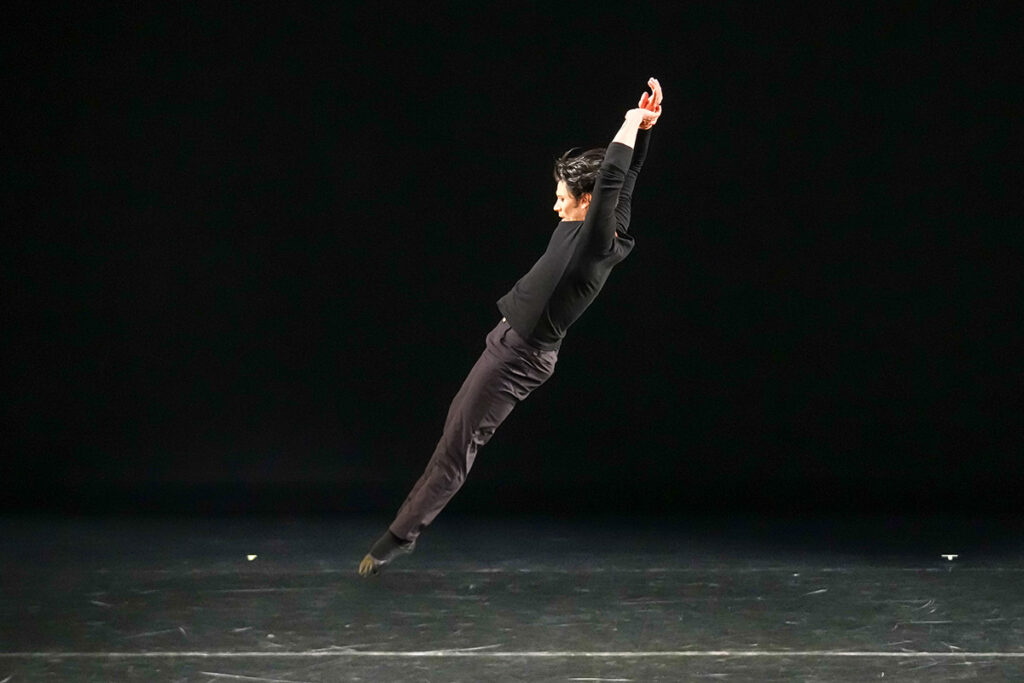VIEWPOINTS – A week of notable dance premieres: TWYLA THARP’s “Brel” and “The Ballet Master”, as well as ALEXEI RATMANSKY’s “Solitude”
- By drediman
- February 16, 2024
- No Comments
It was an exciting week for dance. Both downtown at The Joyce Theater and uptown at Lincoln Center, New York dance fans were treated to the anticipated premieres from two of our marquee choreographers, Twyla Tharp and Alexei Ratmansky. As always, read on for my thoughts.
TWYLA THARP DANCE
The Joyce Theater
Through February 25
On Tuesday, famed choreographer Twyla Tharp unveiled a pair of highly anticipated works at The Joyce Theater in Chelsea (HIGHLY RECOMMENDED). The first of the new pieces was the solo Brel, Tharp’s choreographic homage to the French song stylist Jacques Brel. Set to a recorded medley of Brel’s most enduring anthemic songs, the opening night performance was danced by magnetic American Ballet Theatre star Herman Cornejo (New York City Ballet’s dynamic Daniel Ulbricht performs on alternating nights). As usual, Tharp brought a deceptively casual, almost “throw away” musicality to her interpretation of the Brel songbook, and Cornejo responded with calm gravitas and a disarmingly straightforward style, especially potent in the work’s more introspective moments. Then there was The Ballet Master, arguably the program’s main event. An inspired spin on Don Quixote, the work resets the classic ballet to a dance studio, where a frustrated choreographer — played with verve and personality by longtime Tharp disciple John Selya — is in the process of setting one of his ballets. Prodded by an inner vision of dance excellence (as seductively embodied, in various modes, by the radiant Ballet Theatre principal Cassandra Trenary), he and his company — including Ulbricht, doubling as Selya’s assistant/sidekick and eventually Trenary’s ecstatic partner — eventually get it right, but only after a fun-filled romp of trial-and-error. With this self-referential creation, Tharp defiantly demonstrates that her considerable wit, humor, and grasp on humanity hasn’t dimmed. To note, the evening began breezily with Ocean’s Motion, a 1975 piece set to a mashup of mid-century Chuck Berry songs. Tightly and exuberantly performed, it was an uncomplicated palette cleanser for the exciting new works to come.

NEW YORK CITY BALLET
David H. Koch Theater
Winter season concludes on March 3
Then on Thursday over at the David H. Koch Theater, New York City Ballet performed a program entitled “Innovators & Icons” (HIGHLY RECOMMENDED), which included the world premiere of Solitude, the first ballet choreographed by Alexei Ratmansky as the company’s artist in residence (he joins resident choreographer Justin Peck as one a key member of City Ballet’s artistic team). Dedicated to the victims of the war in Ukraine, the work is based on a photograph of a Ukrainian father kneeling beside the corpse of his son, a casualty of a Russian airstrike. Choreographing to the third movement funeral march from Mahler’s Symphony No. 1 and the fourth movement from the composer’s Symphony No. 5, Ratmansky has created a haunting work that’s resolutely somber and mournful. The ballet’s opening stage picture recreates the image from the photo — on Thursday embodied by principal Joseph Gordon and School of American Ballet student Theo Rochios. Before long, dancers appear, but not as ethereal, benevolent visions. These are specters of the victims of war — earthbound and restless. Their purgatorial angst is conveyed through angular, weaponized steps that threaten and destabilize. As the piece unfolds, their swirling hold on the father’s agonized psychology grows stronger, all but leading to his breakdown, as manifested by a devastating solo (danced with ache and desperation by Gordon). Of the ghosts of war, Mira Nadon, KJ Takahashi, and Sara Means made an impact with their haunted, distinctively charged dancing. Also heartbreaking was Rochios as the son — his purity in striking contrast to the desolation of the landscape. Solitude wasn’t the only piece on the bill, being sandwiched between two City Ballet classics — Jerome Robbins’ mysterious Opus 19 / The Dreamer (principal Taylor Stanley brought quiet magnetism to the role originated by Mikhail Baryshnikov), and George Balanchine’s iconic showstopper Symphony in Three Movements.


 Copyright © 2025
Copyright © 2025
Leave a Reply